Tropical Cyclones
This document describes tropical cyclones and the dangers they pose to coastal populations. It is intended to help teachers improve their content knowledge of these areas. First, tropical cyclones are defined. Section two describes where these storms form, the criteria under which they form, and the forces which act to organize their circulation. Next, structural changes resulting from landfall are discussed. This is followed by a brief description of the four hazards that tropical cyclones pose to coastal populations. The maps provided illustrate how frequently these storms affect Florida and underscore why it is important to continually improve our knowledge about how these systems operate and to understand how these systems might be altered as the Earth’s climate changes.
1. Tropical cyclone definition and formation
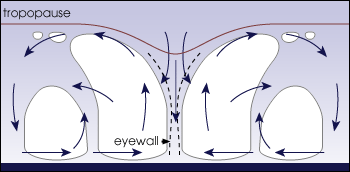
Figure 1. Simple diagram of air flow horizontally and vertically within a hurricane as denoted by blue arrows. The white regions are clouds. Image Credit: NASA http://earthobservatory.nasa.gov/Library/Hurricanes/
| Saffir-Simpson Category | Maximum sustained wind speed meters/sec (mph) | Minimum surface pressure (millibars) |
|---|---|---|
| 1 | 33-42 (74-95) | > 980 |
| 2 | 43-49 (96-110) | 979-965 |
| 3 | 50-58 (111-130) | 964-945 |
| 4 | 59-69 (131-155) | 944-920 |
| 5 | > 70 (> 156) | < 920 |
Table 1. The Saffir-Simpson scale of hurricane intensity developed through damage assessments by engineers.
Tropical cyclones (TCs) are low pressure systems that begin as a collection of unorganized thunderstorms over the tropical ocean. Their role in the global atmospheric circulation is to transport energy from subtropical latitudes towards the poles. Because warm air is less dense than cold air, the air which is heated by the warm ocean waters is able to rise upwards through the cooler layers of the atmosphere above it. This process continually provides heat and moisture to produce thunderstorms. Additional warming happens as latent heat is released through the condensation of water vapor. Latent heat exchange is where energy is used to convert water into a higher state (liquid to gas), or energy is released as water is converted into a lower state (gas to liquid, as happens when clouds form).
As air rises in the developing TC, a relative area of high pressure is created aloft. Pressure gradient force dictates that winds diverge out of this high, which helps intensify the surface low. Air near Earth’s surface is advected (moved horizontally) into the surface low by the pressure gradient force, where it converges and then rises. The air cools as it rises and releases latent heat to provide continued energy for storm maintenance. When more latent heat is released, the surface low deepens, which causes winds to circulate about the storm at higher speeds. Faster winds are able to evaporate more water vapor from the ocean surface to fuel the storm. Figure 1 illustrates these processes.
TCs are categorized according to their maximum sustained wind speeds. For wind speeds below 17 m/s (39 mph), TCs are classified as tropical depressions. Once wind speeds reach 17 m/s, but below 33 m/s (74 mph), TCs are called tropical storms and are given a name (Camille, Katrina, etc.). If wind speeds reach 33 m/s (74 mph) or above, TCs attain hurricane status. Hurricanes are further categorized by their maximum sustained wind speeds and minimum sea level pressures according to the Saffir-Simpson scale (e.g. Category 1-5). Higher category hurricanes are more intense because their maximum sustained winds are faster than those of less intense hurricanes.
The term hurricane is not used throughout the world. It is used in the Atlantic and northeast Pacific basins, while typhoon is used in the northwest pacific. In the remaining three basins (northern Indian, southern Indian, and Australia/southwest Pacific), they are referred to as cyclones.
2. Where TCs form and the forces that control them
Approximately 80 TCs form annually in six of the earth’s tropical ocean basins, specifically: Northwest Atlantic, Northwest Pacific, Northeast Pacific, Southwest Pacific, Northern Indian and Southern Indian (Figure 2). Since the late 1960s, atmospheric scientists have known that seasonal TC formation depends on three temperature and moisture-based parameters:
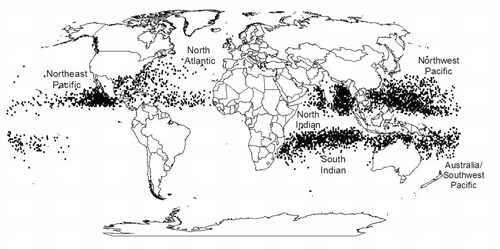
Figure 2. Locations of tropical cyclone formation 1958-1997.
- sea surface temperatures above 26.5°C;
- high amounts of moisture in the mid-troposphere; and
- an unstable atmosphere, which means that heated air parcels can rise freely into the atmosphere where they cool until their dew point temperature is reached and condensation can then take place.
Moreover, daily TC formation requires three motion-type parameters:
- a pre-existing disturbance to provide a localized counter-clockwise spin called vorticity;
- relatively calm winds in the upper troposphere so that rising air columns and the cumulonimbus clouds that are forming can grow into a vertical column without being cut off;
- a minimum distance of 500 km from the equator so that the Earth’s rotation can organize the storm to spin in a counter-clockwise direction in the northern hemisphere through Coriolis force.

Figure 3. Air motion and banded structure of a hurricane showing counterclockwise air flow and the vertical columns of cumulonimbus clouds that produce heavy rainfall. Image Credit: The source of this image is the COMET® Website at http://meted.ucar.edu/ of the University Corporation for Atmospheric Research (UCAR) pursuant to a Cooperative Agreements with the National Oceanic and Atmospheric Administration, U.S. Department of Commerce. ©1997-2008 University Corporation for Atmospheric Research. All Rights Reserved.
This force causes air in the northern hemisphere to be deflected right of its original path, and to the left of the intended path in the southern hemisphere, but the force does not act along the equator. In the northern hemisphere, air flowing into a tropical cyclone moves in a counter-clockwise direction, while it moves in a clockwise direction in the southern hemisphere.
A TC’s vertical structure influences the amount of precipitation produced by a storm: increased latent heating warms the environment inside the clouds relative to the air outside of the clouds, creating an unstable situation as warm air tends to rise above the cold air. This allows clouds to grow taller and discharge more precipitation. As the air flows towards the storm’s center, its rotational velocity increases because it is following a smaller radius, just as an ice skater can increase her rotational speed by drawing her arms and legs inward towards the axis of rotation. So the strongest winds circulate counterclockwise about the storm’s center in the Northern Hemisphere. The balance of Coriolis and centrifugal forces (outward-directed force experienced during curved motion) with the pressure gradient force keeps the storm’s center, or eye, from filling. Additionally, sinking air from the high pressure aloft also inhibits cloud formation in the eye. In a well-formed TC, the eye is completely surrounded by tall cumulonimbus clouds, some of which may breach the tropopause with heights of 18 km. These clouds produce heavy rainfall, and can also be found in the outer rainbands circulating around the storm’s center. Therefore, although the fastest winds in a hurricane are located in the wall of clouds surrounding the eye (i.e., the “eyewall”), rain rates capable of causing flooding can occur both there and hundreds of kilometers outwards from the eye within the rain bands. These details are illustrated in Figure 3.
TC structural variations result from the system’s interactions with the surrounding environment. TCs weaken when any of the carefully balanced elements that sustain the system change. TCs may weaken and eventually dissipate over the open ocean, or dissipate as a result of encountering land. Over the ocean, fast upper-tropospheric winds (called wind shear, which means that wind change direction and or speed with height) can separate cloud tops from their bases, limiting the strength of the storm. Dry air containing dust from the Sahara can also be circulated into the storm so that latent heat release is reduced and the storm weakens. If the storm moves over cool ocean waters, less moisture is evaporated into the atmosphere to continually supply the energy for cloud formation, and the storm weakens.
3. Landfall
Drastic changes occur and weaken a TC when it makes landfall. First, moving over land separates the storm from its energy source. The TC derives its energy from the evaporation of warm ocean water and the uplifting of this water vapor to higher altitudes. Second, moving over land slows wind speeds. In addition, continental air masses, which tend to be drier and cooler, mix with the tropical air masses of the TC and further weaken it.
Observational studies from the 1950s and 1960s found that the loss of the sea surface’s latent heat source, rather than increased friction caused by the land surface, was the greatest contributor to the weakening of a landfalling TC. As a TC moves over land, the rate of evaporation decreases because the land surface contains less liquid moisture than the ocean. As less moisture is carried into the storm, its environment becomes drier. The edges of the clouds begin to evaporate and as evaporation is a cooling process, this causes the air to become more dense and sink. This sinking air cuts off the rising air that supplies the thunderstorms with energy, thus weakening the storm. As less and less moisture is added to the system, cloud coverage lessens and precipitation rates decrease as the storm moves further inland.
The increased roughness of the land surface relative to the ocean surface also changes wind flow within a landfalling TC. Friction is greatest near the Earth’s surface and decreases upwards to an altitude of approximately 1 km, above which it is not felt. This causes winds near Earth’s surface to blow slower than those further aloft. Changes in surface friction upset the balance of forces that act to sustain a TC’s circulation. The pressure gradient force, at first, is unaffected. However, the outward-acting centrifugal force is weakened as the air speed slows. This allows the pressure gradient force to become dominant and air flows into the low at the storm’s center, rather than circling around the center. Once the center begins to fill, pressure gradient force then weakens, which causes wind speeds to weaken. Less moist air is advected into the storm to build clouds, and the storm eventually weakens. The increased roughness of the land surface, which enhances friction experienced by a TC upon landfall, has been found to decrease wind speeds between 20% to 50% of those over the smoother ocean surface.
Although the transition from the ocean to the land surface decreases wind speeds, rainfall can be enhanced near the coastline. As a TC encounters the coast, the increased friction slows the air moving onshore (usually on the right side of the storm in the northern hemisphere), while air transitioning from the rougher land surface back out over the water gains forward velocity (usually the left side of a TC in the northern hemisphere). The air slowing down on the right side of the storm causes convergence, meaning the air comes together just like in a traffic jam. Because it can’t flow downwards into the Earth, it is forced upwards into the atmosphere. This mechanism can transport additional moisture-laden air from the ocean surface upwards to enhance rainfall as the storm is moving over land. On the left side of the storm, air flowing from the land over the water gains speed as friction is lessened, just as happens once a lane on the highway becomes open once again and traffic can speed up. This divergence, or spreading, of winds creates a gap that must be filled by air from aloft. Thus, sinking motion is enabled on the left side of the storm and is one of the reasons why rainfall rates tend to be lower in many cases on the left side of a landfalling TC.
4. Hazards during and after landfall
For many centuries, landfalling TCs have brought disaster to coastal populations through their associated high wind speeds, tornadoes, storm surges, and rainfall. Forecasting where the circulation center, or eye, will come ashore has important implications for winds and the storm surge. As discussed previously, the fastest winds are located in the eye wall, which surrounds the center of circulation. Prior to its passage, wind speeds will increase out of a northeast and then east direction. Once the eye is overhead, a temporary break from strong winds will occur and can last for several minutes. During the 1926 Miami hurricane, residents mistakenly thought the hurricane was over and ventured outside to inspect damage and travel to other locations. They were not prepared for the strong winds on the back side of the eyewall. The winds suddenly pick up speed and come from the opposite direction. Structures and trees that were not completely demolished by the front of the storm can succumb during the passage of the back of the storm because their weakened frames cannot withstand winds from the opposite direction.
Prior to the 1970s, the greatest loss of life from hurricanes was caused by the storm surge. This rise in the normal ocean tides is caused by a combination of the low pressure at a TC’s center and the energy transferred to the water by the strong winds (Figure 4). As a TC approaches the coastline, the ocean becomes shallow. The bottom of the water drags on the ocean floor and causes the water on the surface to rise upwards. The low atmospheric pressure also helps to raise the waters slightly. Strong winds also create tall waves on top of the storm surge. The force of the storm carries the surge and its waves inland. This process is most pronounced on the right side of the storm along the eyewall because the winds are strongest at this location. This is because the storm’s circular rotation is added to its forward velocity to obtain the overall wind speed. Winds on the left side of the storm are moving in opposition to the forward motion, so that the forward motion is subtracted from the circular speed. Additionally, winds are moving away from the shoreline on the left side of the storm so that water is not pushed ashore on the left side of the storm.
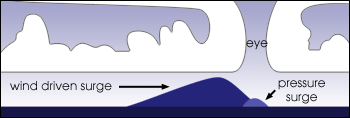
Figure 4. Illustration of storm surge and where it occurs relative to the hurricane’s eye. Vantage point is as if the storm is approaching the viewer. Image Credit: NASA http://earthobservatory.nasa.gov/Library/Hurricanes/hurricanes_2.html
The force of this moving water causes a lot of damage as the energy also turns debris into battering rams. The force of a storm surge can damage levy walls as witnessed during Hurricane Katrina and cause major flooding even when the eye of the storm does not move directly overhead. The largest loss of life from storm surge in the U.S. occurred during the Galveston Texas Hurricane of 1900. The storm had not been forecast to approach the island, so when the surge swept over the entire island, many people drowned. Although the Weather Bureau had been established earlier (1890), this story prompted the government to move the warning center to Washington, D.C., and increase its capabilities. When Hurricane Camille, a Category 5 storm, hit Mississippi in 1969 with a storm surge of 25 feet, many coastal residents heeded the warning and left the area. As a result of such evacuation warnings, the loss of life from storm surges in the US has been greatly reduced.
Fresh water flooding from heavy rainfall was the largest cause of death from U.S. landfalling TCs during 1970-1999. TCs can cause heavy rainfall to occur hundreds of kilometers and several days after landfall occurs and media attention wanes. When encountering a mountain range such as the Appalachians, the ground serves as a wedge to uplift warm and moist tropical air from a TC into the atmosphere to enhance rainfall production. Sloped terrain cannot hold as much water as flat terrain, and flash flooding can occur quickly. Heavy rainfall can also occur near the coastline when the circulation center of the storm remains within 100 km of the shore. It is still able to draw moisture from the ocean surface into its circulation, and the convergence generated by the transition from water to land uplifts the air to increase rainfall.
TCs can also spawn tornadoes both near their circulation centers and farther away within their outer rain bands. More than half of landfalling TCs produce tornadoes, but fortunately most have relative weak winds in comparison to those produced by supercell thunderstorms that can have wind speeds exceeding 200 mph. During the 2004 hurricane season, Hurricanes Frances and Ivan, both of which made landfalls in Florida, produced 108 tornadoes. The record number of tornadoes produced by a single TC was set by Hurricane Beulah in 1967; 141 tornadoes occurred in Texas.
Some TCs produce damage from all four of the hazards described in this section. Hurricane Andrew made landfall as a Category 5 hurricane in 1992 just south of Miami, Florida. It is most famous for the damage caused by its strong winds in the area of Homestead, Florida. Its storm surge also rearranged barrier islands just offshore from Miami. During its second landfall in Louisiana, Andrew also produced more than 10 inches of rainfall, and spawned a deadly tornado. Predicting how many of these storms will form in a given season and where they may make landfall is a difficult task. Although real-time track forecasts have improved significantly over the past 30 years, intensity and rainfall forecasts still need to be improved.
Florida has experienced direct landfalls of more TCs than any other U.S. state. Its elongated shape and location within the subtropics means that TCs forming in the Gulf of Mexico, Caribbean Sea, and the Atlantic Ocean can affect Florida. Figures 5, 6, and 7 (below) show storm tracks of past storms. During the past 48 Atlantic Basin hurricane seasons, 475 named TCs have occurred. Forty percent of the 164 TCs that have made a U.S. landfall have come ashore over Florida. Monroe County, Florida, experiences the highest frequency of hurricane landfalls of any U.S. county at a rate of approximately one every four years. Every resident of and visitor to Florida during the hurricane season, which runs June 1 – November 30, needs to be prepared in case one of these storms makes landfall in the state.
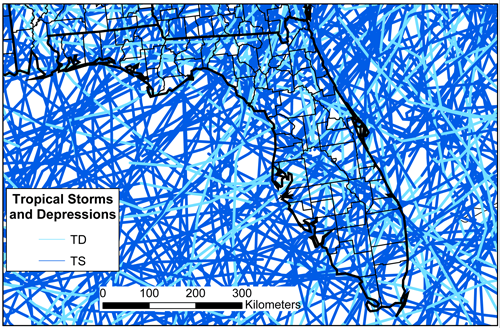
Figure 5. Tracks of tropical depressions and tropical storms passing near to and making landfall over Florida 1851-2006.
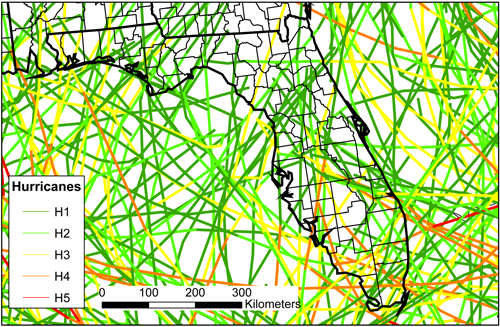
Figure 6. Tracks of hurricanes passing near to and making landfall over Florida 1851-2006. H1 refers to Category 1 hurricanes on the Saffir-Simpson scale and so forth.
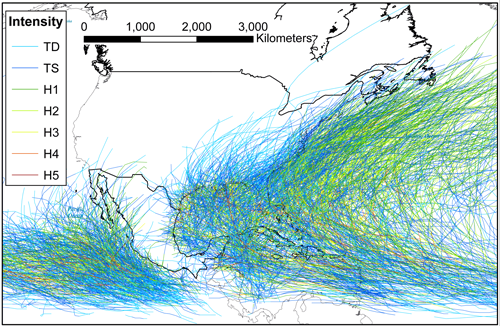
Figure 7. Tracks of tropical cyclones in the North Atlantic and Northeast Pacific ocean basins 1851-2006.